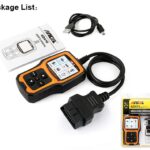Navigating car troubles can be stressful, especially when that pesky check engine light illuminates on your Nissan Sentra’s dashboard. Fortunately, modern vehicles like the Nissan Sentra are equipped with an On-Board Diagnostic (OBD) system, which can help pinpoint potential issues. The key to accessing this system is the OBD2 port. Knowing the Nissan Sentra Obd2 Port Location is the first step in diagnosing your vehicle’s health. This guide will show you exactly where to find it and how it can help you understand your car better.
Locating the OBD2 Port in Your Nissan Sentra
The OBD2 port, standardized across most modern cars, is your gateway to your vehicle’s computer system. For the Nissan Sentra, the OBD2 port is typically located in the driver’s side footwell area.
You’ll want to look under the dashboard, near the steering column. It’s usually not hidden behind panels, but rather openly accessible for easy connection. It might be helpful to get down at floor level and use a flashlight to get a clear view. The port is a 16-pin, D-shaped connector, and you’ll easily recognize it once you’re in the right area.
Finding the OBD2 port in your Nissan Sentra is usually a straightforward process, allowing for quick access to diagnostic information.
Why is the OBD2 Port Important?
This port is crucial because it allows mechanics and car owners to interface with the car’s computer using an OBD2 scanner. These scanners can read trouble codes generated by the car’s system when it detects a problem. These codes are standardized, meaning a P0171 code, for instance, generally indicates a lean fuel mixture issue across different vehicles, including your Nissan Sentra.
By plugging an OBD2 scanner into the Nissan Sentra OBD2 port location, you can:
- Read Trouble Codes: Understand what might be triggering your check engine light.
- Clear Trouble Codes: Reset the check engine light after addressing the issue (or for diagnostic purposes).
- Access Live Data: Monitor real-time data from your engine and other systems, such as engine temperature, RPM, and sensor readings.
- Perform Emissions Tests: Some scanners can help assess your vehicle’s emissions system.
Decoding Common Nissan OBD2 Codes
While a scanner will give you a code, understanding what it means is essential. Here are a few common OBD-II codes that you might encounter in your Nissan Sentra, and their potential causes:
- P0101 (Mass Air Flow Sensor Range/Performance Problem): Could indicate issues with the MAF sensor itself, vacuum leaks, or even a dirty air filter.
- P0300 (Random/Multiple Cylinder Misfire Detected): Points to potential problems with spark plugs, ignition coils, fuel injectors, or vacuum leaks.
- P0420 (Catalyst System Efficiency Below Threshold Bank 1): Often related to a failing catalytic converter or issues with oxygen sensors.
- P0440 (Evaporative Emission Control System Malfunction): Can be as simple as a loose gas cap or indicate a more complex issue within the EVAP system.
- P0507 (Idle Air Control System RPM Higher Than Expected): Suggests problems with the idle air control valve, vacuum leaks, or carbon buildup in the throttle body.
Note: This is just a small sample. The original article provides a more extensive list of codes, which can be a valuable resource if you encounter other codes.
Using an OBD2 Scanner on Your Nissan Sentra
Once you’ve located the Nissan Sentra OBD2 port location, using a scanner is usually very simple:
- Turn off your Nissan Sentra’s ignition.
- Plug the OBD2 scanner into the port.
- Turn the ignition to the “ON” position (but do not start the engine).
- Follow the scanner’s instructions to read codes, view live data, or perform other functions.
Many affordable and user-friendly OBD2 scanners are available for purchase online or at auto parts stores. Having one can empower you to perform basic diagnostics at home, saving time and potentially money on initial mechanic visits.
When to Seek Professional Help
While an OBD2 scanner can be a helpful tool, it’s important to remember that it provides diagnostic information, not necessarily a definitive solution. If you’re uncomfortable working on your car, or if the OBD2 scan reveals complex issues, it’s always best to consult a certified mechanic. Especially for codes starting with “P1” which are Nissan-specific, professional diagnosis is recommended.
If your check engine light persists after you’ve attempted basic troubleshooting, or if you’re unsure about the meaning of the codes, schedule a service appointment with a trusted mechanic or Nissan dealership. They have advanced diagnostic equipment and expertise to accurately diagnose and repair your Nissan Sentra.
Schedule a Service Appointment
Professional technicians have the tools and knowledge to accurately diagnose and repair complex issues identified through your Nissan Sentra’s OBD2 port.
